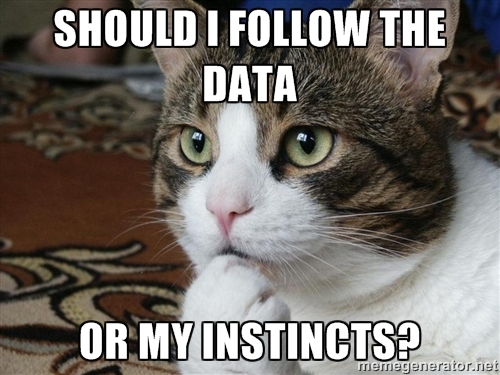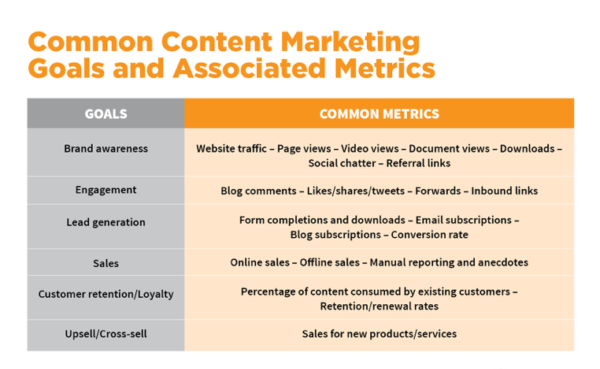How to Create Data-Driven Content Strategy

It’s not just a buzzword — it’s the cornerstone of content marketing.
The internet is getting flooded with new content every day. The big fish, the small fish, you and your competitors are all producing and sharing content. And as the web gets saturated with content, the amount of impact each of those content pieces makes dwindles.
If you want your content to succeed, it needs to reach the right audience at the right time on the right platform. And while it does all of those things, it also needs to deliver the right message. If you can create content that does all that, you’ll be miles ahead of your competition.
But you can’t get there with a generic “spray and pray” content strategy.
What Does “Data-Driven” Mean?
Data-driven content marketers use data and analytics to build their content strategies before any content is produced or published. With the right data, they have a good idea about what kind of content will succeed before it’s actually created.
Smart marketers continue to use data to adapt and pivot their strategies throughout the entire campaign. When the data shows that a certain type of content is working better than others, more time and energy is put into creating that type of content in the future.
When you use a data-driven content marketing strategy, you’re content becomes more focused and more effective as time goes on.
Data-Driven vs. Data-Reactive
Most content marketers use a data-reactive approach to their content strategies. They make their best guess as to what kind of content will get the best results (often based on qualitative data — more on that later) and they produce a ton of content. They hit publish and watch the numbers.
Maybe the content works, maybe it doesn’t. But you can be sure that content marketers using a data-reactive approach will find any metric they can to portray their campaign as a success. A “reporting-in-hindsight” mentality won’t tell you how well you’re content could have done.
The problem with a data-reactive approach is it’s really easy to waste a lot of time and money on content that just doesn’t resonate with your audience. Sure, by the end of the campaign you might have a firm grasp on what sort of “home run” content your audience is looking for, but wouldn’t be better to know that beforehand?
Data-driven content marketers know who their content is for, what kind of content they want to see and where they want to see it. With a data-driven content marketing strategy, you use qualitative and quantitative data to hone in on key metrics about your business, your audience and your market as a whole.
Qualitative vs. Quantitative Data
Qualitative data is collected directly from human sources. Interviews, focus groups, surveys and questionnaires all provide qualitative data on customers and help us form buyer personas. Quantitative data is all about hard numbers. It’s the data we get from our favorite marketing software and analytics programs.
In the book Moneyball, Oakland A’s general manager Billy Beane and his team take a bold, data-driven approach to building a winning baseball team. While the other 29 major league teams were relying on their scouts (qualitative data), Beane was signing players who were putting up outstanding numbers in undervalued but important stats (quantitative data). Surrounded by skepticism, the A’s went on to win their division, with a record-setting 20-game winning streak along the way.
Does that mean we shouldn’t use qualitative data? Of course not. There’s nothing inherently wrong with qualitative data. It gives us a foundation to build our buyer personas and content strategies. But it’s subject to human error. It’s also very difficult to scale.
What we should be doing is using qualitative data as a starting point to produce a “rough sketch” of our buyer persona. Then we use quantitative data (with analytics software) to turn that sketch into a crystal-clear picture. We learn our market’s demographic and which social networks they use. We learn whether or not they like articles or videos or infographics. And we learn it before we create any content.
How to Get Data-Driven
- Set specific, measurable goals. Your goals will provide a roadmap for the rest of your content strategy. Create goals that are ultra-specific. And set a deadline for them. Having “100 new subscribers in 3 months” is going to be much better than “increase our page views and subscribers.”
You want to make sure your goals are measurable. Vague goals will produce lackluster results. Each goal should have a metric you can easily check to see if you’re on-track to meet your benchmarks.-
Metrics to associate with your content marketing goals
-
- Study your competition. You can learn a lot about your audience by what your competition is doing. And don’t just look at the big players in your market — small companies can be very effective at carving out a small, loyal niche.
Take a look at what kind of content is boosting your competitors’ reach. If they are crushing it with two-minute YouTube videos, short video content is probably an area worth exploring.
- Use predictive analytics. You can get a good idea of what kind of content works by looking at past results. Take a look at your best-performing content from previous campaigns. What sets that content apart from the weak performers?
It could be the content length (short-form vs. long-form), the type of headline (numbered lists, controversial headlines) or the type of content (how-to’s, lists, infographics). Spend a good amount of time combing through past results and you’re bound to notice some patterns. Pareto’s Law applies here — 80% of your results often come from 20% of your efforts.
- Adjust your strategy as you go. The most powerful part of a data-driven content strategy is its adaptability. If you’re doing it right, the data analysis never stops. Since the nature of content consumption on the internet is always changing, you might stumble upon some new revelations mid-campaign.
And it’s a good thing. You want to be receptive to new data and be flexible enough to change course when the numbers warrant it. Having to periodically correct your approach doesn’t mean you have a bad strategy. Periodically correcting your approach is the strategy.
Tools You Need to Get Data-Driven
There are plenty of tools out there for the data-driven content marketer to use. Ahrefs, BuzzSumo, SEMrush and Ceralytics can all provide you with enough metrics and analytics to create a flexible and predictive content strategy.
All of these programs are fantastic, but they come with a price tag. And the reason they can charge so much is because they can gather so much more data than a human can doing manual research.
There are some free tools out there that can give you some basic data to work with. Google Analytics will tell you all about how users are interacting with your content. You can see how many views each piece of content is getting, where the traffic is coming from and how long visitors are staying on the page.
SEMrush allows you to do some basic research on keywords and competitors (10 searches per day) for free without paying for their whole package. Moz also offers limited free daily searches for keyword research.
At the end of the day, free options will only get you so far. If you really want to get serious about data-driven content marketing, you’re going to have to pony up for one of the premium services eventually.
Get Started
You can start taking your content marketing strategy in a more data-driven direction right away. Start by going through all your old content. You can use your favorite premium analytics tool or Google Analytics.
Look for the stand-out pieces, the content with the most clicks, views and engagement. What is it that makes them stand out from the rest of your content? How are users interacting with the content? Are they finding it through search or is it getting shared around on social? Come up with a list of 5 qualities that your most successful content has. Keep this list handy when you start thinking about your next content marketing campaign.
How useful was this post?
Click on a star to rate it!
Average rating 4 / 5. Vote count: 2
No votes so far! Be the first to rate this post.
Free training: Be confident around anyone
Join our free training and learn:How to be more confident around anyone.
How to stop feeling self-conscious using the "OFC-method".
Why you don't need out-of-your-comfort-zone exercises to be confident.
Why some are so confident despite not having the looks, money, or a "cool job".
Start my free training.
mdollareditor




